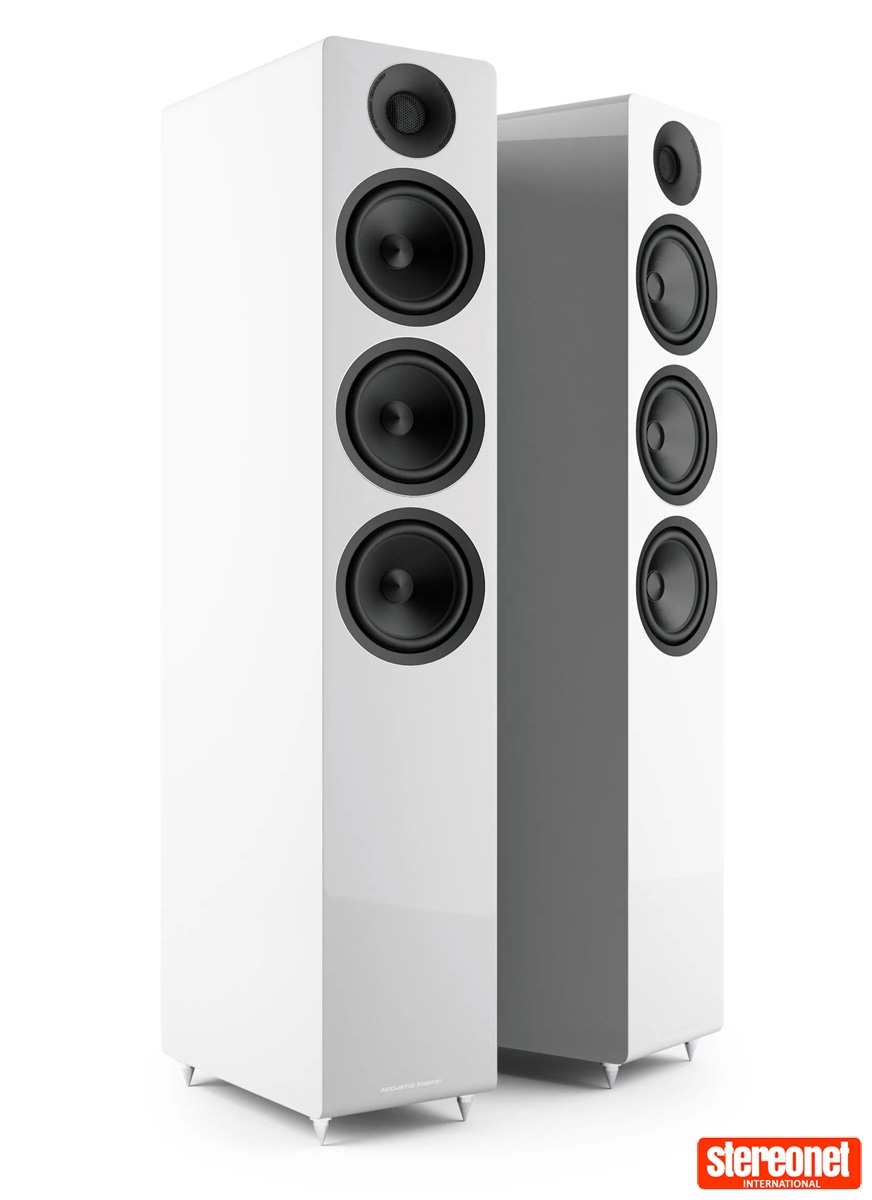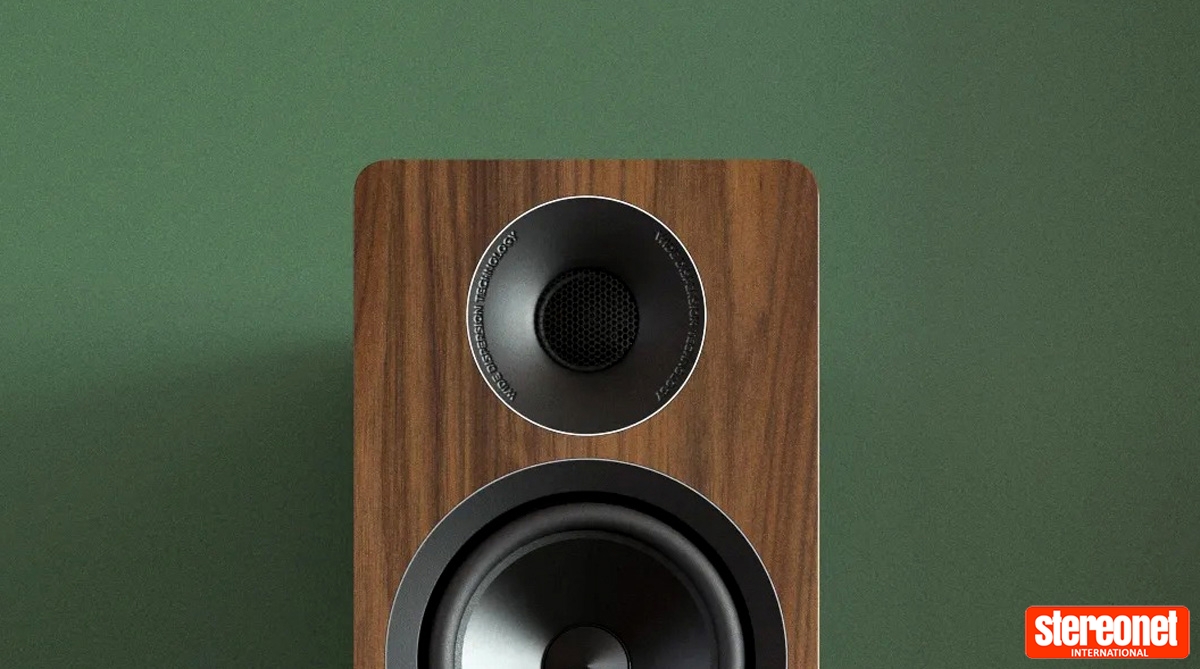Acoustic Energy AE320 Floorstanding Loudspeaker Review

David Price is blown away by this larger sized budget floorstander…
Acoustic Energy
AE320 Floorstanding Loudspeaker
from £1,599

For a good long while, I maintained a healthy scepticism about floorstanding speakers. If you spend much of your life listening to loudspeakers of all shapes and sizes – and get the chance to compare standmount and floorstanding variants of the same designs from manufacturers' model ranges – it's easy to not like them. Why? Because what you gain on the swings, you often more than lose on the roundabouts…
By this, I mean that although floorstanders offer bigger cabinets, and the ensuing likelihood of deeper, stronger bass and higher efficiency, they also bring with them the likelihood of insufficient cabinet strength and not enough bracing. Especially with budget designs, where the product is built down to a price, this makes for poor sound due to the drop in rigidity and torsional strength of the box. It makes for bloated, squelchy bass and muddy midrange, compared to smaller standmounting versions of the same design, with identical drive units.
So, the loudspeaker Lord giveth, and he taketh away. The challenge for designers like Matt Spandl and James Luce at Acoustic Energy is to maximise the pros and minimise the cons when they do big floorstanders. When you're talking £1,599 products such as the AE320 you see here, it's harder still – as it's not cheap to make a strong, stiff box in a largish size such as this. Measuring 1,000x175x320mm (HxWxD) and weighing 26kg, I can think of few – if any – larger floorstanders in this price category. At least on the surface, the AE320 screams 'value for money'.
The devil is in the detail, though, which is why I was interested in how this speaker is made. Its MDF cabinet walls are 18mm thick, which is more than many at this price point, and there's a good amount of bracing inside. The lower section of the speaker is preloaded with what Acoustic Energy calls 'an inert mass material', which increases internal damping, thus reducing cabinet colouration. It's a delicate balance, James tells me, because you don't want to damp all the life out of the cabinet; at this price, it's always going to add something, and it's more a question of whether what it adds helps or hinders the sound. Internal volume is a massive (at the price) 35 litres. 8mm floor spikes are supplied, and the AE320 comes in a choice of Piano Gloss White, Piano Gloss Black, plus Real Walnut wood veneer for a small additional cost.
Of course, loudspeakers do not succeed by cabinets alone and need decent drive units. Sadly the 300 series doesn't get the lovely carbon fibre dome tweeter and midrange and bass drivers of the more expensive AE500 series, but James says some tricks have been used to get the best out of the 28mm aluminium dome tweeter. It uses thinner metal than is usual, meaning that it weighs in at almost the same as AE's high-end carbon dome. "This speaker's drivers are more affordable but are still far from run-of-the-mill, all the same", he says. Three newly designed 130mm ceramic aluminium sandwich coned mid/bass drivers are fitted, with a long-throw design and a flatter cone profile than before.

The job of marrying all these drivers together is done by a new crossover that sports a mix of first and second-order filters similar to the AE520. An impedance correction circuit is used on the midrange to prevent unwanted resonances. The 3-way design crosses over at 380Hz and 3.4kHz. "High voltage film caps, a mixture of wire-wound and metal oxide resistors are used with air core inductors on key elements", James adds. The two lower bass units give the effect of a much larger diameter single woofer which would be impossible to fit in this narrow-baffle tower type design.
Acoustic Energy's favoured slot-type port is used, as you'd expect. I'm not a particular fan of reflex ported speakers, thinking that often the benefits they bring don't make up for the problems that they cause; poorly done, you get slow, bloated bass or phase issues. Yet this arrangement has worked well in the company's other speakers, providing pretty unobtrusive. Tuned to 42Hz and vented to the rear, it allows closer positioning to rear walls than many speakers I've heard. "It reduces audible chuffing compared to a circular port because it's less susceptible to jetting – which is a high-speed gush of air in the middle of a round port which generates a lot of the extra noise", James tells me.

All together, these different aspects of the AE320's design make for a speaker with a claimed 35Hz to 30kHz (-3dB) response – which is excellent. Sensitivity is quoted as 90dB/1w/1m, which is also very good and means this speaker can go loud with low-powered Class A solid-state amplifiers and valve amps. It's said to be an easy load, too, apparently dropping no lower than 4.8 ohms at 150Hz and having a nominal impedance of 8 ohms – so you don't need a muscular amp to drive it. If however, you do have one, then it will soak-up up to 200W RMS. Overall it's a great 'real world' budget speaker, then – because getting a decent amplifier/speaker match with inexpensive equipment is half the battle to achieving good sound.
THE LISTENING
Sonically the AE320 is very well rounded, with deep, strong, powerful bass, a relatively clean and open midband and a surprisingly polished treble for a product of this price. Better still, it throws a capacious soundstage into any listening room, conveying music on a scale you would not expect. Yet this speaker isn't just a 'big banger', as it has the company's fleet-footed rhythmic 'get up and go', too.
Roxy Music's More Than This is a great test of any speaker – a beautifully recorded, dramatic listening experience when played through the right kit. The AE320 made an impressive job of it – serving up a gutsy, large-scale rendition of this classic early eighties rock track. The opening drum hits, which lead into the first verse, sounded quite epic; even when driven by a relatively low-powered NVA S80 power amplifier, they came over as visceral 'thwacks'. The shuffling groove of the song was as enjoyable as the dynamics, and Bryan Ferry's chocolatey voice hovered in an almost ethereal way in a surprisingly engulfing soundstage.

The midband is a very long way from the quacky, nasal or hazy presence regions of most relatively inexpensive floorstanders. Whilst it cannot approach the delightful performance of Acoustic Energy's 500 series speakers, it's still decently detailed and open. Tonally smooth and well integrated with both what was going on below and above, the AE320 showed surprisingly low levels of cabinet colouration. There is some, of course, but it's not intrusive – and nor does it spoil things.
This means that you can enjoy more simple programme material, such as Suzanne Vega's Luka, with ease. This is a more vocal-based track with folk influences, and the basic honesty of the speaker let me hear well into the mix and enjoy the recording's delicacy. The AE320 also correctly identified that this is not as polished sounding as the Roxy Music track; unlike many relatively affordable speakers, it doesn't make all recording studios sound the same. The intimate, fragile quality of the vocals were well carried, as was the sparse sound of the backing band. Again, the speaker got into the groove and had fun, almost as much as I did!

All reassuring stuff then, but the AE320 is at its best when let off the leash and allowed to flaunt its barrel-chested, muscular character. Fed with some pounding electronica courtesy of Leftfield's Not Forgotten, it really soared. Those bass units moved serious amounts of air around the room, proving way gutsier than any similarly priced floorstander I've heard. Better still, the bass line kept in time, with the bass drum and bass synth line driving the song along. At the other end of the frequency range, this speaker made a classy job of those drum machine hi-hat cymbals; there was no obvious brightness, yet they still sounded crisp and clean.
In absolute terms, there's a slight lack of definition and low-level detail resolution, but the AE320 still sounds way better than you have a right to expect. Its big bass sound is ever so soft too, but never slurs the beat of the music – indeed, it's quite a pleasing effect. Whilst not having the complete inertness of more expensive speakers, the cabinet holds everything together really well – even at very high listening levels.

THE VERDICT
 Acoustic Energy's AE320 is an object lesson in what's possible from a speaker of this price. It has no obvious weak points, unlike so many rivals, and this, in turn, lets you enjoy its strengths – which are myriad. You will, however, need a medium to largish room to place a pair of them in, as they'll overpower smaller environments. It's a really impressive product then and does more than just give you 'a big bang for your buck'.
Acoustic Energy's AE320 is an object lesson in what's possible from a speaker of this price. It has no obvious weak points, unlike so many rivals, and this, in turn, lets you enjoy its strengths – which are myriad. You will, however, need a medium to largish room to place a pair of them in, as they'll overpower smaller environments. It's a really impressive product then and does more than just give you 'a big bang for your buck'.
For more information visit Acoustic Energy
David Price
David started his career in 1993 writing for Hi-Fi World and went on to edit the magazine for nearly a decade. He was then made Editor of Hi-Fi Choice and continued to freelance for it and Hi-Fi News until becoming StereoNET’s Editor-in-Chief.
Posted in: Applause Awards | 2022 | Loudspeakers | Floorstanding | Hi-Fi
JOIN IN THE DISCUSSION
Want to share your opinion or get advice from other enthusiasts? Then head into the Message
Forums where thousands of other enthusiasts are communicating on a daily basis.
CLICK HERE FOR FREE MEMBERSHIP
Trending
applause awards
Each time StereoNET reviews a product, it is considered for an Applause Award. Winning one marks it out as a design of great quality and distinction – a special product in its class, on the grounds of either performance, value for money, or usually both.
Applause Awards are personally issued by StereoNET’s global Editor-in-Chief, David Price – who has over three decades of experience reviewing hi-fi products at the highest level – after consulting with our senior editorial team. They are not automatically given with all reviews, nor can manufacturers purchase them.
The StereoNET editorial team includes some of the world’s most experienced and respected hi-fi journalists with a vast wealth of knowledge. Some have edited popular English language hi-fi magazines, and others have been senior contributors to famous audio journals stretching back to the late 1970s. And we also employ professional IT and home theatre specialists who work at the cutting edge of today’s technology.
We believe that no other online hi-fi and home cinema resource offers such expert knowledge, so when StereoNET gives an Applause Award, it is a trustworthy hallmark of quality. Receiving such an award is the prerequisite to becoming eligible for our annual Product of the Year awards, awarded only to the finest designs in their respective categories. Buyers of hi-fi, home cinema, and headphones can be sure that a StereoNET Applause Award winner is worthy of your most serious attention.





